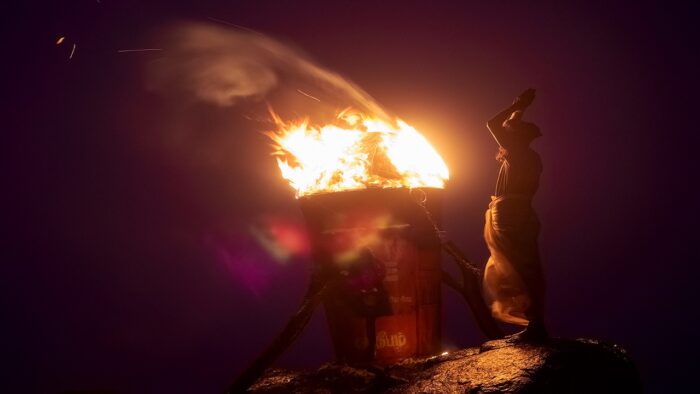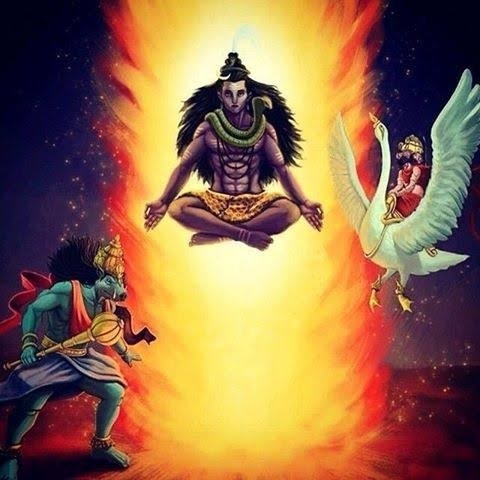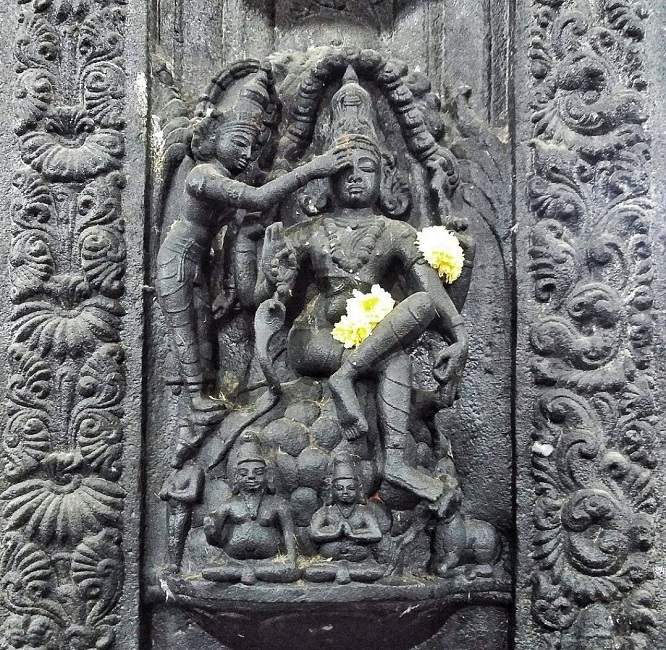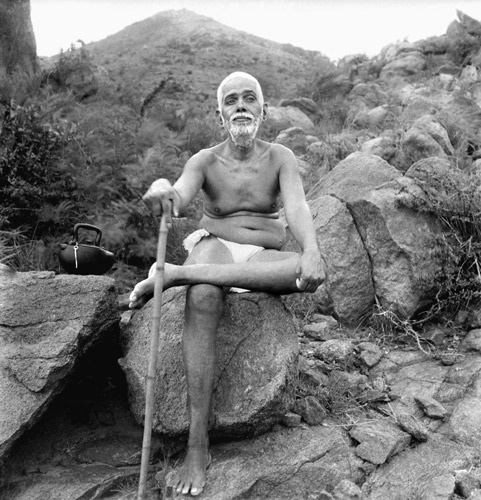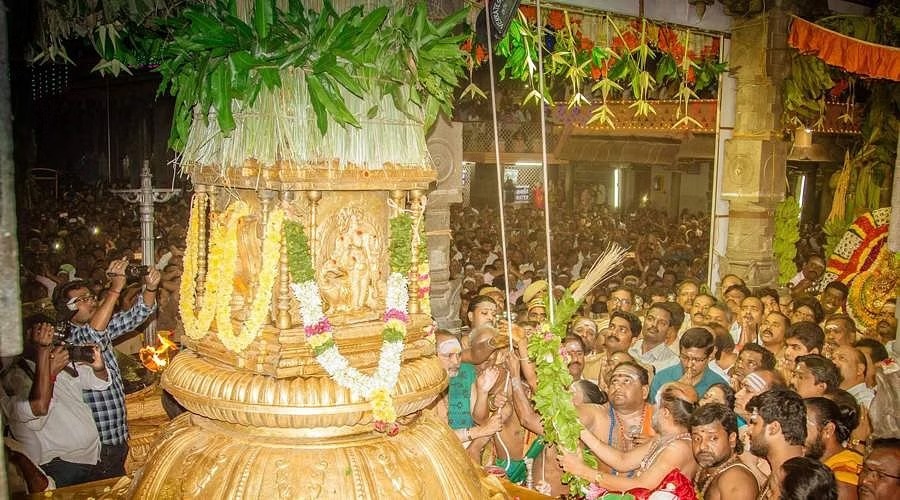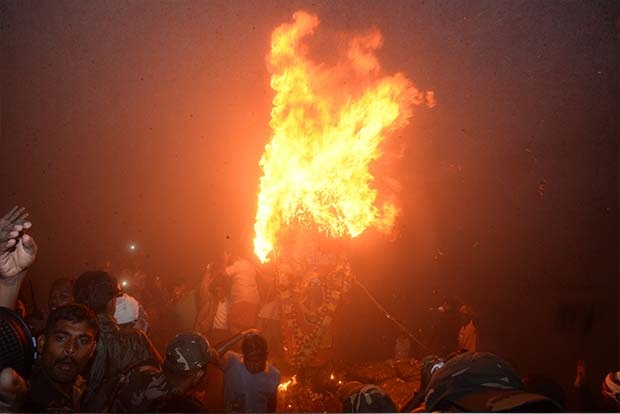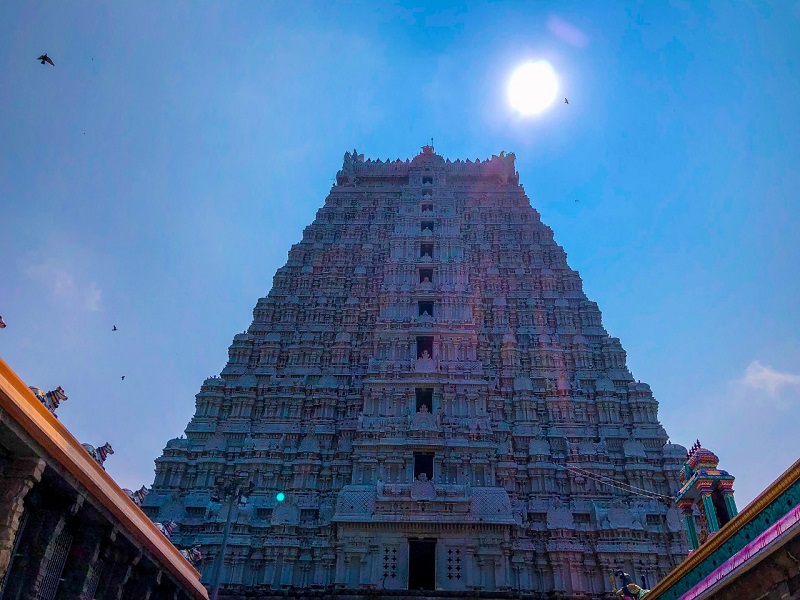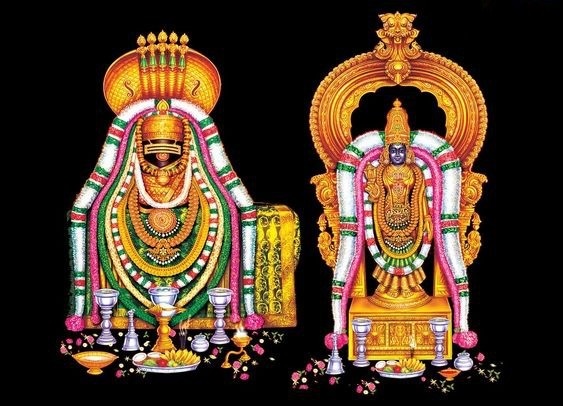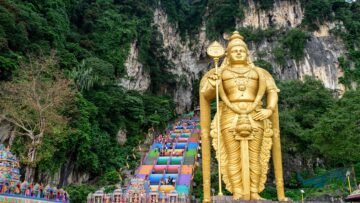Karthigai Deepam, Thirukarthikai is a festival of lights that is observed mainly in Tamil Nadu, but also in Kerala, Andhra Pradesh, Telengana, Karnataka and Sri Lanka. Tamil Nadu celebrates Karthigai Deepam as a traditional festival. This festival is very important for Tamilians all over the world. The full-moon day of the Karthigai month is called Karthigai Purnima. In Kerala, this festival is known as Thirukarthikai, celebrated to welcome Goddess Katyayani (Chottanikkara Amma) Bhagavati. In the rest of India, a related festival called Karthik Purnima is celebrated on a different date. It is celebrated in the name of ‘Lakshabba’ in the Nilgiris district of Tamil Nadu. The name of the festival is born from the name of the God Karthikeya. The Karthigai month starts in the middle of November, coinciding with the entry of the Sun into the Scorpio. From that day onwards, till the end of the month, oil lamps are lit everyday. On Karthigai Purnima (full moon of Karthigai month), oil lamps with 365 wicks prepared at home are lit in Shiva temples.
It is on this day that the huge beacon of light is lit on the holy hill Arunachala in South India. When the light on the top of the Tiruvannamalai hill (Arunachala) is unveiled on the Karthigai Deepam day, people see the big light or Jyoti and worship it. They recite again and again in a loud voice “Harohara”. The esoteric meaning is that he who sees the festival of lights that is burning eternally in the chambers of his heart through constant meditation attains immortality. The light on the Arunachala brings the message that the Self or Lord Shiva is effulgent. He is the light of lights.
On Karthigai Deepam day in South India, people make bonfires in front of temples in the evening. It is said that Shiva burnt the chariots of several demons who were torturing sages and celestials. This bonfire symbolises this legend. People also light a variety of fireworks. People place rows of earthen lamps surrounding the main lamp (diya) held by an elephant made of bronze in front of their houses in the evening of Karthigai Deepam and worship the deity. They pray for the welfare of the family, especially the brothers. Naivedya is offered to the lamps. The brothers give gifts to their sisters.
Annihilate the three impurities, namely, egoism, selfish action and delusion. Burn the mind, senses and desire in the fire of knowledge of the Self or Shiva-Jnanam. Attain full illumination and behold the light of Lights, which illumines the mind, intellect, sun, moon, stars, lightning and the fire. This is the real Karthigai Deepam. (Ref. Hindu Fasts and Festivals by Sri Swami Sivananda).
History
One of the earliest references to the festival is found in the Aganānūru, a book of poems which dates back to the Sangam period, (200 BCE to 300 CE). The Aganānūru clearly states that Karthigai is celebrated on the Purnima of the month of Karthigai in the Tamil calendar. It was one of the most important festivals of the ancient Tamils, including now the areas of modern Kerala too. Avvaiyar, the renowned poet of those times, refers to the festival in her song. It is referred to in the Sangam literature as Peruvizha.
Arunachala in Vedas and Puranas
Figure 1: Credit: Twitter (Shiva as a column of Agni)
The Vedas have given importance to the worship of Agni. The reason is that Sri Arunachala, the Supreme Being chose to appear as a column of Agni. A column of effulgence which has no dimension, pervading all space and time transcending all human comprehension. As He chose to appear as Jnana Agni to quell Avidya, i.e. ignorance, the Vedas begin by singing His praise. Thus all Vedic hymns dedicated to Agni are actually dedications to Arunachala.
He is the light immortal within mortals. Established firmly, He perceives all. (Rig Veda, VI-9-4). Apart from Rig Veda and Yajur Veda, the Rig Veda, Brahmana, the Kenopanishad and the Bhaskara Samhita describe the Lingodbhava, i.e. the dazzling column of light which covered the cosmic space, covering the frontiers of time and space. The brilliance is far too magnificent for the sense organs to perceive or even the mind to imagine. The grandeur of this column of jyoti stunned the lesser Gods. Brahma and Vishnu were not separate from the column of effulgence. Yet they, in their own divine illusion, felt apart from it and failed to realize their oneness with that Supreme light. They could not understand what that jyoti was. So, they started to find out the beginning and end of it. Brahma took the form of a swan and flew up to find the upper end of this column and Vishnu took the form of a boar and dived down to find the bottom. As they failed in their mission, they came back and prayed to the Jyoti to take a concrete form. Being pleased with their prayer, Lord Shiva took the form of a Sthavara Linga, Tejo Linga i.e., Arunachala Hill. This is the origin of the hill.
It is said that in Krita yuga, the linga was in the form of a flame (Jyoti), in Treta yuga it became a hill of jewels, in Dwapara yuga it appeared like a hill of gold and in Kali yuga it appears like a hill of Maragatha. At present, the colour of the hill is reddish like copper. (Ref. Temples of Tamilnad by R. K. Das).
Figure 2: Credit: Twitter (Devi Parvati closing the eyes of Shiva)
Once, Goddess Parvati, the consort of Siva, sportingly closed the eyes of Siva for a short while (nimisha (one minute)). The eyes of Siva are the moon, sun and fire. As Parvati obstructed the vision of the eyes of Siva, the sun, moon and fire could not perform their duties. As the nimisha of Lord Siva is equivalent to several years in worldly computation, the clock of time had to be set back, which led to miscalculation and upset all natural laws.
Many sages approached Siva and Parvati and acquainted them about the situation. Siva reprimanded Parvati that she, being the Creator and Mother of this Universe should not have done this and the only remedy for it was to do the act of Prayaschitta (corrective remedy).
Under orders from Siva, Parvati came to EkambaraKshetra near Kanchipuram, made a Siva Linga of sand and started prayaschitta. To test the sincerity of Parvati, Siva ordered nature to cause a flood and heavy storm near the place where Parvati was worshipping the Linga. The place all round was surrounded by water and with a view to save the Sivalinga from flood, Parvati clasped it to her heart. As she pressed the Lingam made of sand, the impression of Parvati’s ornaments on her bosom fell on the Sivalinga, whereupon an unknown voice uttered that Parvati’s prayers were perfect and that next she should go to Arunachala Hill, the hermitage of Maharshi Gautama and worship there. Thereupon Parvati came to Arunachala Hill and sage Gautama expounded the greatness of Arunachala Hill to her. It is further said that when Parvati was in prayaschitta at the hill, demon Mahishasura came to the place and caused mischief. So Parvati took the form of mother Durga and killed Mahishasura. As Mahishasura was a devotee of Siva, Sage Gautama advised Parvati to strike a sword against the Arunachala Hill by way of prayaschitta. It was done. At once a teertham was formed at the spot and it came to be known as the Khadga Teertham.
Siva said to Parvati that she had not incurred any paapa or inappropriate action by the act of killing Mahisha. Moreover, as she has looked at Arunachala, all her paapa were dissolved. Her eyes have been blessed. In order to do prayaschitta, Parvati had left behind her baby son Karthikeya, unable to breastfeed him. This is considered a great tyaga or sacrifice for a mother. That is why she is known as Unnamalai (mother of the unsuckled breasts) in the month of Karthigai. Goddess Parvati, henceforth will be worshipped as Apitakuchambika (the Sanskrit equivalent for Unnamalai).
Parvati meditated on her Lord surrounded by the flames of five fires. When the auspicious full-moon day of Karthigai soon dawned, a divine effulgence was seen on the peak of the red hill on the evening of that day. She was wonderstruck at it and circumambulated the hill making obeisance to Siva at every step and praised Him with love and devotion. On seeing this, Siva appeared before her with great compassion and showed her his universal form. He praised Parvati who had undergone severe prayaschitta and untold hardships in order to win his love. Siva said that he is Purusha and she is Prakriti. She is knowledge and he is the object of knowledge. She is the word and he is the meaning. He is Isvara and she is part of him. It is from them that the acts of creation, sustenance and destruction emerge and are carried on. She and he are inseparable. Siva said that henceforth Parvati shall be a part of me and shall become the left-half of my person. Goddess Parvati thus won the left portion of Siva and Arunachala thenceforth was called as Ardhanarisvara.
On Krittika Nakshatra in the month of Karthigai, Lord Siva became visible to Parvati in the form of a Jyoti. On that day, the chief festival of Tiruvannamalai is conducted. On that occasion, a huge beacon is lit at the top of the hill in commemoration of the Jyoti.
Figure 3: Credit: Shaivam.org (Bhagavan Ramana Maharishi)
Tiruvannamalai is also the place chosen by Bhagavan Ramana Maharshi for his spiritual practice and stay. The Ramanashram is situated on the side of Arunachala Hill.
Giripradakshina
The greatness of the Giripradakshina has been described at length in Arunachala Purana. The word pradakshina has a very precise meaning. The letter ‘pra’ stands for removal of all kinds of sins, ‘da’ stands for fulfilling desires, the syllable ‘kshi’ stands for freedom from future births, ‘na’ stands for giving deliverance through jnana. One of the 1008 names given to Arunachala by Adi Sankara is Giripradakshinapriya – The Lord who loves Giripradakshina (circumambulation of the hill). The greatness of going around the hill as said by Bhagavan Ramana is that Parvati who was doing tapas around the hill on the day of the Karthigai star had darshan of the holy beacon (Deepam) and she was absorbed in Siva.
Another story says that Sage Durvasa once cursed two Vidyadharas. They then pleaded before him to be merciful, forgive and redeem them from the curse. Durvasa said that “The curse cannot be lifted by any act except that of circumambulating the Arunachala Hill”. The Lord of Arunachala Hill is a repository of compassion and his glory is so great that circumambulating the hill on foot is a means of releasing from suffering.
Karthigai Deepam
This festival falls in the month of Kartigai (November-December) when the star Kritika is on the ascendant and usually occurs on a full moon day. When Sri Muruganar asked Bhagavan Ramana about the significance of the Karthigai Deepam festival, Bhagavan Ramana composed a stanza in four lines in which he says “The true significance of the Karthigai Deepam festival is to turn the intellect inwards and have it fixed in the heart, thereby merging it with the indweller of the heart”. This festival is not confined to the temples alone, but involves the whole town. In the Tiruvannamalai temple, the preparation for the festival begins with the Pandalkal Muhurtham, a simple ceremony held to mark the commencement of the various arrangements. The main festival is of ten days duration only.
Figure 4: Credit: Dinamani (Celebrations begins with dhwajārohanam)
The first day begins with the hoisting of the flag called dhwajārohanam and attended by a large number of people. The tenth day of the festival marks the climax of devotion which is dormant in the people’s hearts. Their devotion triggered by the hoisting of the flag and increasing in intensity day by day, finally reaches its zenith on the tenth day, the day of the great Deepam. In the morning, one can witness the Bharani Deepam as a prelude to the Maha Deepam or Karthigai Deepam. One can see people from all walks of life, from almost all parts of the State, some from other parts of India and yet a few from abroad pouring into this small town. It is heartening to see that whatever the differences in language, culture or attitudes, they all come out of extreme love and devotion for Arunachala; to witness the jyoti that the Lord will reveal atop the holy hill keeping His promise which He gave the Gods, aeons ago.
Figure 5: Credit: Dtnext (Annamalai Deepam)
On the previous night, the temple premises are cleared of people to prepare the temple for the Bharani Deepam. The significance of Bharani Deepam is that the Universal Lord manifests as the five elements and during the evening he again becomes the One Entity and shines as Tejolinga when the Deepam is lit atop the hill. (Bharani is one of the twenty-seven stellar constellations through which the moon is purported to pass though successively each day and according to the Hindu almanac Bharani precedes Kritika). The earthen pot lamps are taken in procession around the temple. A fire torch is lit from these lamps and taken to the top of the hill. A copper cauldron is kept ready on the summit filled with ghee, camphor and wick of cloth.
Exactly at 6 p.m, in the temple, the idol of Ardhanariswara is brought out and aarati is shown to the Lord. (We may mention here, that this is the only occasion when the idol of Ardhanariswara is brought out, just for a few seconds). A thundering blast of crackers signals the men on the top of the hill to light the beacon. As the moon rises in the eastern sky, the first flame of the beacon bursts forth in the clear sky stirring emotions of ecstasy and devotion. Thousands, nay lakhs of voices applaud in unison, “Aṇṇāmalaiyārukku Harohara” (glory to Annamalayar). Even the heretic and unemotional spectators are awed and moved by the sublime sight. The beacon burning brightly, the emotional hailing of the devotees filling the air, and the full moon spreading its rays on the hill, all create a magical spell and the vibrant presence of the Lord is powerfully felt in the innermost hearts of the devotees.
Figure 6: Credit: Istock (Annamalai Gopuram)
After the beacon is lit, the devotees start on their giri-pradakshina. Some join the multitudes on the outer path, mind and gaze fixed on the beacon, while some wanting to be alone with Arunachala, take to the inner path. That night and successive nights the beacon leaves a strange and everlasting impression on the onlooker.
The Deepam burns for seven, nine, eleven or thirteen days and at about six every evening it flares up and burns throughout the night. During these few nights, it is a rare experience to perform giripradakshina. The Deepam is visible for miles around. There is a strange fascination about it. It keeps our sights riveted on it. To walk around Arunachala slowly with our attention fixed on the light, without thoughts is a unique experience. Nothing exists in the universe for the devotees – no stars, no moon, no sky, nothing except Arunachala. There is just the holy beacon and Arunachala. The individual merges in both.
Probably to witness this phenomenon, Arunachala himself goes around the hill on the second day following the Deepam, when Lords from both the temples on the east and west come in a procession around the hill. They accept the worship due to them from their devotees. This then is the glorious festival of Deepam.
Figure 7: Credit: Youtube (Arunachaleshawara and Apithakuchambaal)
Once Shri Appaya Deekshitar had gone to Tiruvannamalai for darshan of lord Arunachaleswara. There he was laid up with severe fever. At that time he composed a poem in eight verses in praise of Devi Apitakuchamba. He got immediate relief. Even now a devotee can get relief from fever and other ailments by reciting this poem on Unnamalai Amman (Apitakuchambika):
त्वंसाक्षिणीप्रलयभैरवताण्डवानाम्त्वंशेषिणीसहरिधातृचराचराणां l
त्वंमोचिनीसकलसंसृतिजालकानांत्वांब्रह्मसंविदमपीतकुचेनमामिll
Conclusion
The festival is a reminder to turn inward and recognise the ceaseless light.
कीटा: पतङ्गा: मशकास्चवृक्षाःजलेस्थलेयेविचरन्तिजीवाः l
दृष्ट्वाप्रदीपं न च जन्मभागिन: भवन्तिनित्यंश्वपचाहिवृक्षाःll
The sloka means that insects, birds, mosquitoes, trees, creatures that live in water, as well as human beings, learned or otherwise, see the light of the lamp and get freed from the cycle of birth and death.
The significant aspect of the Karthigai Deepam celebration is that there is scope for moksha or enlightenment (which is cessation of birth/death cycle) for every creature. This sloka indicates that Isvara does not distinguish among beings, and a simple gesture of lighting a lamp can elevate the beings from this samsara chakra.
Feature Image Credit: istockphoto.com
Disclaimer: The opinions expressed in this article belong to the author. Indic Today is neither responsible nor liable for the accuracy, completeness, suitability, or validity of any information in the article.

